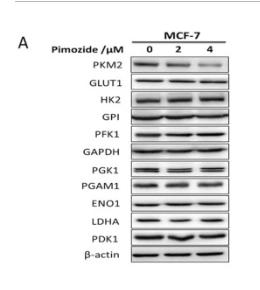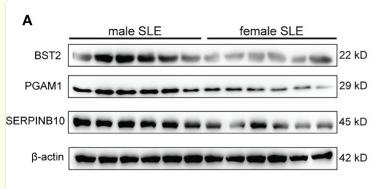PGAM1 Antibody - #DF12693
| Product: | PGAM1 Antibody |
| Catalog: | DF12693 |
| Description: | Rabbit polyclonal antibody to PGAM1 |
| Application: | WB |
| Cited expt.: | WB |
| Reactivity: | Human, Mouse, Rat |
| Prediction: | Pig, Bovine, Horse, Sheep, Rabbit, Dog, Chicken, Xenopus |
| Mol.Wt.: | 29 kDa; 29kD(Calculated). |
| Uniprot: | P18669 |
| RRID: | AB_2845654 |
Related Downloads
Protocols
Product Info
*The optimal dilutions should be determined by the end user. For optimal experimental results, antibody reuse is not recommended.
*Tips:
WB: For western blot detection of denatured protein samples. IHC: For immunohistochemical detection of paraffin sections (IHC-p) or frozen sections (IHC-f) of tissue samples. IF/ICC: For immunofluorescence detection of cell samples. ELISA(peptide): For ELISA detection of antigenic peptide.
Cite Format: Affinity Biosciences Cat# DF12693, RRID:AB_2845654.
Fold/Unfold
BPG dependent PGAM 1; BPG dependent PGAM1; BPG-dependent PGAM 1; OTTHUMP00000059414; PGAM 1; PGAM A; PGAM B; PGAM-B; PGAM1; PGAM1_HUMAN; PGAMA; PGAMB; Phosphoglycerate mutase 1; Phosphoglycerate mutase 1 brain; Phosphoglycerate mutase A; Phosphoglycerate mutase A nonmuscle form; Phosphoglycerate mutase isozyme B;
Immunogens
A synthesized peptide derived from human PGAM1, corresponding to a region within the internal amino acids.
- P18669 PGAM1_HUMAN:
- Protein BLAST With
- NCBI/
- ExPASy/
- Uniprot
MAAYKLVLIRHGESAWNLENRFSGWYDADLSPAGHEEAKRGGQALRDAGYEFDICFTSVQKRAIRTLWTVLDAIDQMWLPVVRTWRLNERHYGGLTGLNKAETAAKHGEAQVKIWRRSYDVPPPPMEPDHPFYSNISKDRRYADLTEDQLPSCESLKDTIARALPFWNEEIVPQIKEGKRVLIAAHGNSLRGIVKHLEGLSEEAIMELNLPTGIPIVYELDKNLKPIKPMQFLGDEETVRKAMEAVAAQGKAKK
Predictions
Score>80(red) has high confidence and is suggested to be used for WB detection. *The prediction model is mainly based on the alignment of immunogen sequences, the results are for reference only, not as the basis of quality assurance.
High(score>80) Medium(80>score>50) Low(score<50) No confidence
Research Backgrounds
Interconversion of 3- and 2-phosphoglycerate with 2,3-bisphosphoglycerate as the primer of the reaction. Can also catalyze the reaction of EC 5.4.2.4 (synthase), but with a reduced activity.
Acetylated at Lys-253, Lys-253 and Lys-254 under high glucose condition. Acetylation increases catalytic activity. Under glucose restriction SIRT1 levels dramatically increase and it deacetylates the enzyme.
Expressed in the liver and brain. Not found in the muscle.
Belongs to the phosphoglycerate mutase family. BPG-dependent PGAM subfamily.
Research Fields
· Human Diseases > Cancers: Overview > Central carbon metabolism in cancer. (View pathway)
· Metabolism > Carbohydrate metabolism > Glycolysis / Gluconeogenesis.
· Metabolism > Amino acid metabolism > Glycine, serine and threonine metabolism.
· Metabolism > Global and overview maps > Metabolic pathways.
· Metabolism > Global and overview maps > Carbon metabolism.
· Metabolism > Global and overview maps > Biosynthesis of amino acids.
· Organismal Systems > Endocrine system > Glucagon signaling pathway.
References
Application: WB Species: Human Sample: MCF-7 cells
Application: WB Species: Human Sample:
Restrictive clause
Affinity Biosciences tests all products strictly. Citations are provided as a resource for additional applications that have not been validated by Affinity Biosciences. Please choose the appropriate format for each application and consult Materials and Methods sections for additional details about the use of any product in these publications.
For Research Use Only.
Not for use in diagnostic or therapeutic procedures. Not for resale. Not for distribution without written consent. Affinity Biosciences will not be held responsible for patent infringement or other violations that may occur with the use of our products. Affinity Biosciences, Affinity Biosciences Logo and all other trademarks are the property of Affinity Biosciences LTD.



